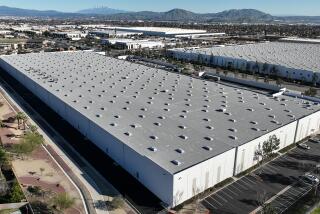Mayor Revs Up Plan for Rush-Hour Curbs on Trucks
- Share via
Mayor Tom Bradley is putting the finishing touches on a politically sensitive plan intended to help relieve street and highway congestion by restricting truck traffic during morning and evening rush hours.
Exactly how the plan will work is being closely guarded by the mayor’s office, and compromises could still be made. But sources familiar with the proposal say it is expected to be a pioneering effort to discourage peak period truck traffic with new city fees on trucking firms and businesses that receive deliveries during the most congested periods.
Through their emissions and those of other vehicles slowed in traffic by truck-related accidents, trucks operating during peak hours contribute disproportionately to the region’s air pollution, AQMD officials said.
The Bradley effort is being strongly encouraged by the South Coast Air Quality Management District, which is viewing the city plan as a major pilot project.
Authority Boosted
The state recently increased the AQMD’s authority to fight smog, including empowering it to ban rush-hour truck traffic. But so far the agency has focused more narrowly on developing a regionwide plan similar to Bradley’s that would restrict rush-hour activities of shipping and receiving businesses.
“From what we’ve been told . . . we’re just anxious for (Los Angeles officials) to adopt their (plan) and implement it,” said John Dunlap, the AQMD’s director of community relations.
Bradley has a number of incentives for pressing ahead. City officials are desperately searching for air-pollution reduction programs in the face of threats by the federal Environmental Protection Agency to halt all city development. The EPA claims that the city has hindered the region’s efforts to control smog by encouraging too much growth and exceeding population targets.
Also, Bradley is looking ahead to a possibly tough reelection campaign against Councilman Zev Yaroslavsky and polls show that street and freeway congestion is a key issue with some voters and that restricting rush-hour truck traffic is popular.
Widespread Impact
If approved by the City Council--where the measure could face strong opposition from trucking and retail business groups--the program could affect thousands of businesses and workers who presumably would have to adjust their hours to make the program work.
Bradley first announced that he would seek to restrict rush-hour truck traffic in June, 1987, when he unveiled an eight-point plan to relieve traffic congestion.
Several other elements of the plan--including ordinances requiring companies to develop ride-sharing plans and beefed-up ticket-writing and towing of illegally parked cars and delivery trucks that block traffic flow--have already been approved by the City Council.
But the truck traffic restrictions, among the more complex and controversial of the mayor’s proposals, moved slowly. “This must be done with care because you are talking about the fundamental arteries of commerce in the region,” said William Bicker, Bradley’s chief transportation policy adviser who has been working on the plan. But “everybody’s got to give a little bit. It’s time for the goods-movement community to offer and deal in a serious fashion with their share” of the problem.
Bradley will present the proposed truck traffic regulations soon. But, citing the sensitivity of negotiations with trucking and business interests, Bicker refused to divulge details. “(We are) basically fine-tuning the key issues,” he said.
Ron Lamb, a Los Angeles Chamber of Commerce executive who has been involved in the discussions, said the plan is expected to include a “partial ban” on rush-hour truck traffic. Lamb said draft documents he has seen indicate that part of the proposal will be directed at restricting operations of trucking firms in the city by imposing as-yet-undisclosed fees on any trucks operated during morning and evening commute periods.
Another part of the plan will seek to regulate businesses that receive goods, Lamb said, by requiring them to pay special fees to accept deliveries during rush hours.
The California Trucking Assn. and the Western Traffic Conference, representing 7,500 major retail outlets on the West Coast, have criticized the Bradley plan, saying any truck traffic management should be voluntary. They argue that any mandatory regulation of truck traffic may not be within the city’s legal authority and would be highly disruptive to business. Karen Rasmussen, a spokeswoman for the trucking association, said there is already a shortage of qualified truck drivers to work during the day. Under the city’s plan, she said, “they would have to have drivers who are willing to work at night, with all the support personnel . . . warehouse workers, dispatchers.”
How much a reduction in rush-hour truck traffic would help relieve congestion is unclear and something the trucking and retailing lobbies say needs further study. The preliminary results of a state-funded study of rush-hour truck traffic in the Los Angeles region has found that overall, large trucks make up 4.5% of the morning freeway traffic and 2.5% of the afternoon traffic. The study estimates that the region’s commuters last year experienced up to 20 million hours of delay because of truck-involved accidents.
But Will Recker, director of the Institute of Transportation Studies at UC Irvine, said that study and others have not established whether truck-related delays are a major part of the problem, or just a drop in the traffic congestion bucket.
More to Read
Sign up for Essential California
The most important California stories and recommendations in your inbox every morning.
You may occasionally receive promotional content from the Los Angeles Times.










